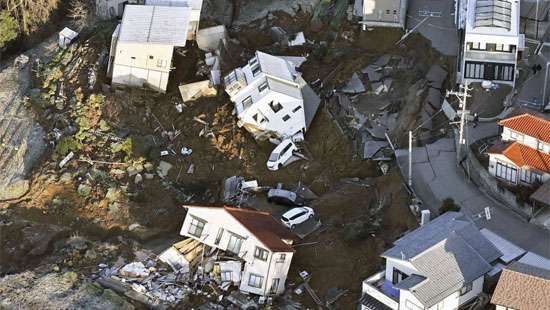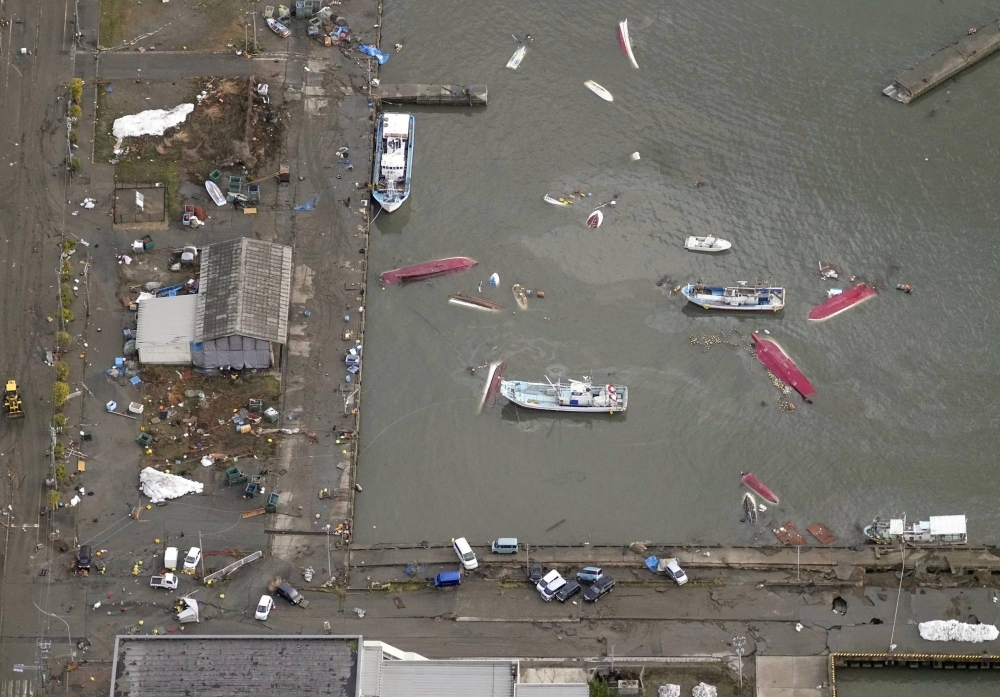Reply To:
Name - Reply Comment

 Japan, Jan 02 ( The Japan Times) - Authorities in Japan on Tuesday rushed to assess the damage the day after a powerful earthquake left at least 30 dead, led to landslides and the collapse of multiple buildings, sparked a large-scale fire in a popular tourist area, and triggered a tsunami warning for the length of the nation’s west coast.
Japan, Jan 02 ( The Japan Times) - Authorities in Japan on Tuesday rushed to assess the damage the day after a powerful earthquake left at least 30 dead, led to landslides and the collapse of multiple buildings, sparked a large-scale fire in a popular tourist area, and triggered a tsunami warning for the length of the nation’s west coast.
Continuing aftershocks, rubble on roadways and damaged roads were hampering rescue operations amid a race to find survivors.
Footage taken by the broadcaster NHK on Tuesday morning showed a seven-story building toppled over sideways and smoke rising in a central area of Wajima, Ishikawa Prefecture, known for its morning market, where a large blaze broke out Monday.
Fires engulfed over 200 structures in the central Wajima area but have been bought under control, Ishikawa officials said.
Ishikawa Gov. Hiroshi Hase wrote on X that roads have been cut in widespread areas by landslides or cracking, while in the port of Suzu, "multiple" vessels had capsized.
The 7.6 magnitude earthquake, which at its center was rated the highest-level 7 on Japan’s shindo intensity scale, struck Ishikawa Prefecture’s Noto Peninsula on Monday afternoon, as the nation was marking New Year’s Day — when families generally gather at home and many shops are closed.

The quake was centered around 30 kilometers east-northeast of Wajima with a provisional depth of 16 km.
The quake triggered a rare major tsunami warning and forecasts that waves of up to 5 meters could strike, but by 10 a.m. Tuesday, all warnings and advisories had been lifted. The highest tsunami recorded was said to be over 1.2 meters at Wajima Port in Ishikawa.
The Meteorological Agency said on Tuesday that while waves are not likely to grow larger, sea level changes were still being observed, encouraging people in areas that had been under tsunami warnings to refrain from marine-based work.
While fears of a major tsunami — reminiscent of the deadly waves that struck Japan’s northeast coast following the Great East Japan Earthquake Disaster in March 2011 — did not materialize, the quake itself appears to have caused widespread damage, with the death toll likely to rise as rescuers moved through the disaster area.
Some of the deaths confirmed so far appear to have been caused by people being trapped or buried in collapsed buildings. Structures are reported to have collapsed in Niigata, Toyama, Fukui and Gifu prefectures, leading to multiple injuries.

According to Ishikawa Prefecture, 15 have been confirmed dead in Wajima, six in Suzu, five in Nanao, two in Anamizu and one each in Hakui and Shika. The deaths included seven victims at Wajima Municipal Hospital, city officials said.
In Wajima, 25 houses are reported to have collapsed, with a likelihood of people being buried under rubble at least 14 of the sites.
A team of firefighters crawled under a collapsed commercial building in Wajima looking for survivors, television footage showed.
"Hang in there! Hang in there," they shouted as they battled through piles of wooden beams with an electric saw.
A duty officer at the Wajima Fire Department said authorities were still being overwhelmed Tuesday by rescue requests and reports of damage.
At least three homes collapsed on a hillside in Kanazawa, Ishikawa Prefecture, but other areas of the neighborhood appeared to be safe from damage.
Prime Minister Fumio Kishida said Tuesday morning that the government had established an emergency disaster local response headquarters in Ishikawa to assess the situation and offer support.
“As time passes, the effect of the disaster is becoming more and more clear,” Kishida said. “Saving the lives of the disaster victims is a race against time.”
The Self-Defense Forces set up a joint task force and dispatched 10,000 personnel to engage in rescue and relief operations.
As darkness fell on the area on Monday night, news reports showed a massive blaze in the Kawaimachi district of Wajima. The fire, which burned shops and homes, was put under control around late morning, while extinguishing efforts continue. The area is a popular tourist spot, known for its Asaichi street.
It was unclear if the fire had led to injuries or deaths. According to local police reports, around 200 buildings are believed to have burned from the fire in Wajima. Officials said the earthquake hindered firefighting operations, according to NHK. An expert told the broadcaster that confusion following the quake may have led to the spread of the fire, and that it may have spread easily due to the area’s predominantly wooden structures.
A total of over 46,000 people have evacuated across Ishikawa and Toyama prefectures as of Tuesday morning. Over 160 people evacuated in Noto island in the city of Nanao, however because roads are closed on the bridge that connects the island to the mainland, supplies are unable to reach the area.
Since the initial quake, which struck at around 4:10 p.m. on Monday, there have been over 129 aftershocks of shindo 2 or higher, as of 6 a.m. on Tuesday. On Monday, the Meteorological Agency warned that quakes of up to shindo 7 could strike the area again over the next week, urging caution especially over the next few days.
The quake also impacted the nation’s transport network and left passengers stranded. Some shinkansen lines and flights in the area were canceled after the quake. Four trains on the Hokuriku Shinkansen that were between Toyama and Kanazawa stations were left at a standstill for 11 hours with a total of 1,400 passengers aboard. Train lines began to come back online later Tuesday.
Around 32,900 households in Ishikawa Prefecture and 330 households in Niigata Prefecture have lost power. Some areas of Ishikawa, Toyama, Fukui and Nagano prefectures have also been cut off from water supplies.
There are also reports that 16 medical facilities in Ishikawa, two in Niigata and one in Toyama are experiencing power and water outages.
While some areas are experiencing difficulties with phone and internet services, three major telecommunications operators — NTT Docomo, KDDI and SoftBank — are working on setting up a free Wi-Fi service called“00000JAPAN” in affected regions.
Road closures have also impacted the delivery of goods in the area, with major delays being seen in Niigata, Ishikawa, Toyama and Fukui, according to Japan Post. Major convenience stores in the region, including 100 Seven Eleven stores and 160 Family Mart stores, are temporarily closed as well.
According to the weather agency, the Noto peninsula is expected to see rain between Tuesday night and Thursday, warning that even a small amount of rain could result in a landslide.
A shindo 7 quake is described as making it impossible for people to remain standing. Such a temblor was last recorded in 2018 in Hokkaido, the weather agency said. Until Monday, a major tsunami warning hadn't been issued in the nation since the 2011 disaster.
The country's geodetic survey system recorded significant land movement, with a reference station in Wajima moving 1.3 meters westward, the Geospatial Information Authority of Japan said.
Foreign governments including those of the United States, Canada and Italy offered support.
In Washington, President Joe Biden said in a statement released after the quake that the United States will provide "any necessary assistance for the Japanese people."